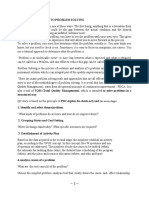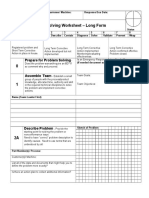Problem Solving Form - Blank
Uploaded by
campnkid1Problem Solving Form - Blank
Uploaded by
campnkid1Owner: Area: PROBLEM SOLVING FORM Theme (circle): Safety Quality Delivery 1. Clarify the Problem - GO SEE it 2.
Breakdown the Problem
Describe current situation / status:
Date Started: Date Complete: Cost Other: 3. Set an Improvement Target
What should be happening? ( what is standard?) Achieve what?
Where does it happen? When did it start?
How big an issue? By when?
4. Find Point of Cause (POC)-GO SEE & Walk Process Steps Back to Where Problem is 1st Occurring/ Let part tell story
Document PROCESS FLOW Start where problem found > Work Upstream > Investigate Process by Process See problem? Yes ` No
5. Investigate - GO SEE the POC Process(es), Ask Questions & Make Assumptions of What Caused the Problem
If a quality problem: Not regular operators? Operator not trained? No SOS? Parts not to spec? Wrong parts? Setup/shutdwn not done? Parts in mixed locations? Tools not working? Done differently on shifts? Wrong tools used? Tools/fixt not good shape? Gages not in spec? (GR&R) Oper doesn't know quality stds.? Error proofing not working?
What do you think could have caused this problem?
Rank 1-5 for Most Likely Causes
PROBLEM
Main Categories
HuMAN MACHINE MATERIAL METHOD
MEASUREMENT ENVIRONMENT Specific (write-in) Processes Positions Machine #
\\vboxsrv\conversion_tmp\scratch1531\67320506.xls.ms_office
6. Find the Root Cause - GO SEE & Prove/Disprove your Assumed Causes 1x1 - use 5 Whys - Focus on Item # Most Likely Cause Fact? # Most Likely Cause
Fact?
7. Develop Action Plan - Implement Actions - Evaluate the Effectiveness at Eliminating Problem Brainstorm possible solutions. Select the most cost effective # Root Cause Action/Idea Who Due Date
Prob Elim?
8. Verify the Results & Standardize Controls Target Conditon from 1st page achieved? wk 1 Y N wk 2 Y N wk 3 Y N wk 4 Y N If no, return to step 4 Have you changed the process? Y N If yes, check all that need done Update/post SOS Update LPA Post visual aids Organize/5S workarea Update control plan Update/post CTQ Update PMP Retrain Operators Update gage control Post Quality Alert Update/post SU/SD Update pFMEA Training matrix Update fixture control Post Process Alert Actions Who Due Date Complete
Lessons Learned (what can be shared) Could other departments benefit from this? (circle)
If Yes, send copy of this to: Yes No
\\vboxsrv\conversion_tmp\scratch1531\67320506.xls.ms_office
You might also like
- Line 3 Conveyor VFD Short 5P-Problem-Solving-FormNo ratings yetLine 3 Conveyor VFD Short 5P-Problem-Solving-Form6 pages
- 5 Why Problem Solving Process (Incident Investigation)No ratings yet5 Why Problem Solving Process (Incident Investigation)14 pages
- The Performance Consultant's Fieldbook: Tools and Techniques for Improving Organizations and PeopleFrom EverandThe Performance Consultant's Fieldbook: Tools and Techniques for Improving Organizations and PeopleNo ratings yet
- You Exec - Problem Solving Frameworks FreeNo ratings yetYou Exec - Problem Solving Frameworks Free13 pages
- Power Point For Apply Problem Solving Techniques and Tools96% (28)Power Point For Apply Problem Solving Techniques and Tools93 pages
- (PS) Honda PSS 5 Step Problem Solving Process (Handout)No ratings yet(PS) Honda PSS 5 Step Problem Solving Process (Handout)17 pages
- Apply Problem Solving Edited For StudentsNo ratings yetApply Problem Solving Edited For Students27 pages
- Quality Circles: Manufacturing Excellence ModelNo ratings yetQuality Circles: Manufacturing Excellence Model21 pages
- Training On Root Cause Analysis / Problem Solving Techniques100% (1)Training On Root Cause Analysis / Problem Solving Techniques66 pages
- Investigation of Direct Cause: Related Depts Preparation Date: DeptNo ratings yetInvestigation of Direct Cause: Related Depts Preparation Date: Dept8 pages
- Problemsolvinganatomy 110110112157 Phpapp01No ratings yetProblemsolvinganatomy 110110112157 Phpapp0131 pages
- Kaizen PDCA (Plan / Do / Check / Act) : Training Pack100% (2)Kaizen PDCA (Plan / Do / Check / Act) : Training Pack24 pages
- Quality Management: Heidi Maier SagstadNo ratings yetQuality Management: Heidi Maier Sagstad67 pages
- Quality Management: Heidi Maier SagstadNo ratings yetQuality Management: Heidi Maier Sagstad67 pages
- Root Cause Analysis: 1.define The ProblemNo ratings yetRoot Cause Analysis: 1.define The Problem5 pages
- The Power of Business Process Improvement: 10 Simple Steps to Increase Effectiveness, Efficiency, and AdaptabilityFrom EverandThe Power of Business Process Improvement: 10 Simple Steps to Increase Effectiveness, Efficiency, and AdaptabilityNo ratings yet
- 5S- The True Mean to Enhance Productivity and Work Value for Customers: Toyota Production System ConceptsFrom Everand5S- The True Mean to Enhance Productivity and Work Value for Customers: Toyota Production System Concepts5/5 (1)
- P3O® Foundation Portfolio, Programme and Project Offices Courseware – EnglishFrom EverandP3O® Foundation Portfolio, Programme and Project Offices Courseware – EnglishNo ratings yet



























































